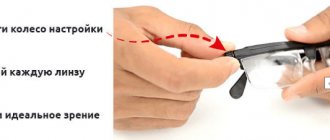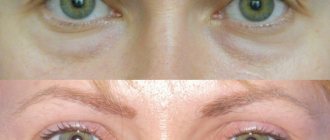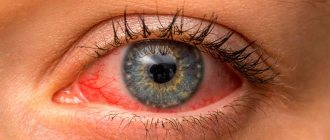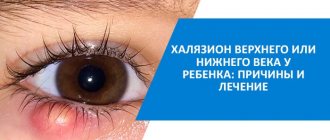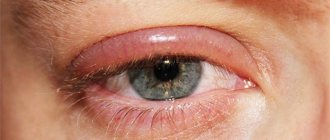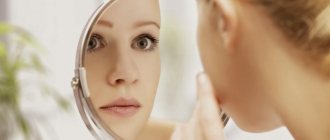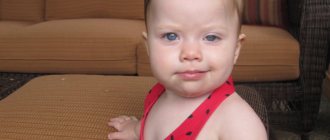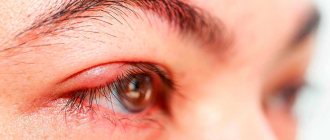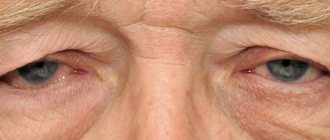General overview
Ectropion of the eyelid is a pathological change in the location of the skin edge, in which it begins to lag behind the eyeball, turning outward.
According to statistics, ophthalmological disease occurs equally often in men and women.
The congenital form of the pathology is considered a rare anomaly, diagnosed in one patient out of a thousand.
A similar phenomenon is observed only in the lower eyelid. The cartilaginous plate of the lower eyelid is quite thin, and this makes it susceptible to various types of deformations.
Clinical picture
At the initial stages of the disease, patients have no unpleasant symptoms.
However, as the inversion increases, the following signs of the disease develop:
- Tearing. Normally, tear fluid constantly washes the conjunctiva of the eye, flowing into the lacrimal punctum along the lower eyelid. With the development of eversion, this becomes impossible. As a result, fluid accumulates between the eyelid and the eyeball, overflowing;
- Swelling and maceration of the eyelid. Watery eyes cause swelling of the eyelid skin, reducing its strength and elasticity;
- Sensation of a foreign body or sand due to dryness and irritation of the mucous membranes of the eye;
- Infection of the unclosed eyelid due to disruption of the natural cleansing of the eye from particles of dirt and microorganisms;
- Development of signs of keratitis. In the absence of therapy, clouding of the cornea, development of ulcers and decreased visual acuity are observed.
Clinical manifestations and causes
Most often, eyelid inversion is not an independent disease, but develops as a consequence of other conditions.
It is extremely important to establish the true cause of the pathology, since further treatment tactics will depend on this.
Congenital eversion
An extremely rare pathology explained by the shortened dimensions of the cutaneous-cartilaginous plate of the lower eyelid. Often combined with other autoimmune diseases.
If the deformity is not clearly expressed, the disease does not require treatment. Surgical intervention to narrow the distance to the ciliary edge is carried out only in case of a significant deviation from the norm.
For example, when a child sleeps, a gap is noticeable, during the day the baby is bothered by constant lacrimation, and vision decreases.
Spastic eversion
This form of the disease develops as a result of chronic inflammatory processes occurring in the area of the eyelids and conjunctiva.
Such conditions lead to constant tension in the muscle fibers and spasm of the orbicularis oculi muscle.
Mechanical eversion
Mechanical ectropion is a displacement of the eyelid under the pressure of a volumetric neoplasm formed in the eye area.
Most often, the pathology occurs in elderly patients. Correction of deformity is possible only after removal of the formation.
How to recognize ptosis of the upper eyelid, is treatment possible without surgery, and how effective is it? Come here to find out how dangerous blepharoptosis is.
At this address https://cosmetolog-expert.ru/plastika-litsa/veki/uprazhneniya-ot-morshhin.html watch a video with exercises for the face against wrinkles.
Cicatricial eversion
In this case, we are talking about pulling outwards and shortening the eyelid plate as the skin scars at the site of the scar maturation.
Pathology is diagnosed at any age. The main reason is trauma, burns, surgery and some skin diseases.
Treatment is surgery to excise the scar followed by correction of the eyelid position. If the deformity is severe, skin grafting may be required.
The prognosis for patients is favorable. With ectropion due to chronic skin diseases, relapses are possible .
Paralytic ectropion
Paralytic ectropion is a drooping eyelid due to paralysis of the facial nerve and decreased tone of the facial muscles.
Treatment options and prognosis will depend on the cause and persistence of the condition. If the condition temporarily worsens, you can get by by prescribing moisturizing medications to prevent the cornea from drying out.
With complete paralysis of the facial nerve or progression of the disease, surgical intervention is indicated .
Age inversion
Age-related changes that occur in the skin provoke weakness of the soft tissues of the face and their drooping. With age, the degree of deformation constantly increases, causing exposure of the cornea.
A mild form of pathology usually does not require radical treatment, and all conservative methods are limited to the use of moisturizing drugs. In difficult cases, plastic surgery is required.
Classification of ectropion of the century
Based on the pathogenesis of the disease, the following classification of ectropion of the eyelid is distinguished:
- Congenital.
Pathology occurs infrequently. Violation of embryonic development causes shortening of the cartilaginous plate of the lower eyelid. For mild symptoms, no special treatment is required. Surgical therapy is performed in severe cases of deformity. - Spastic.
Occurs as a consequence of inflammation processes affecting the eyelid area and conjunctiva, which causes spastic contraction of the orbital orbital muscle. - Mechanical.
It is caused by displacement of the skin due to the impact of pressure on them during the growth of a malignant neoplasm. The problem can only be resolved surgically. - Scar.
It is formed as a result of a scar formed after an injury, burn or surgery. Severe cases of deformity can only be corrected by skin grafting. - Paralytic.
It is observed with a cut or paralysis of the facial nerve, since in this case the tone of the facial muscles decreases. - Age.
In the pathogenesis of this form, the main role is played by the loss of elasticity of the muscles and ligaments of the facial area, resulting in their drooping. With timely treatment, the pathology is eliminated by conservative treatment methods.
Symptoms
Ectropion of the eyelid is determined visually even with partial lag of the ciliary edge. Normally, the glands located under the eyelid produce the necessary amount of tears to moisturize the mucous membrane of the eyes and protect against foreign particles.
Violation of the mechanism of tear fluid outflow forms the clinical manifestations of the pathology.
Main symptoms of the disease:
- Formation of a gap between the eyeball and the edge of the skin. At the same time, the mucous membrane of the eyelid, located on its inner surface, is exposed. During blinking, incomplete closure of the eyelids can cause discomfort.
- Tearfulness of the eye. Impaired outflow of tear fluid leads to its accumulation in the corners of the eyes and flow down the cheek, and not through the nasolacrimal duct, as it should be.
- Dryness and foreign body sensation in the eye due to loss of moisture from the conjunctiva. The same symptom provokes frequent blinking, with the help of which the body tries to moisturize the mucous membrane.
- Redness of the skin of the eyelids caused by irritation with tear fluid.
- Conjunctivitis (inflammation of the conjunctiva), as a result of mechanical removal of tears and disruption of the physiological process of cleansing the eyes of dust particles and pathogenic microflora.
In the future, the described symptoms may be joined by signs of keratitis - clouding of the cornea, redness of the eyes and pain when blinking. Over time, patients experience a decrease in visual acuity.
Symptoms of eyelid inversion
Tearing
occurs due to disruption of the normal outflow of tears.
Tear is produced by the lacrimal gland, the produced tear washes the eyeball and, forming the so-called tear duct, between the lower eyelid and the eyeball, is absorbed into the lacrimal openings on the inside of the upper and lower eyelids.
90% of the tear flows through the inferior lacrimal punctum and then through the lacrimal sac and nasolacrimal duct into the nasal cavity. Therefore, if the tight contact of the lower eyelid with the eyeball is disrupted, the tear cannot flow down the lacrimal rivulet into the lacrimal punctum and accumulates between the eye and the eyelid, and then simply rolls down over the edge of the eyelid.
Irritation
of the skin
of the eyelid occurs due to lacrimation. The constant production of tears and mechanical irritation of the eyelid when trying to wipe the eye leads to the skin of the eyelid becoming red, swollen, and irritated.
Feeling of foreign body, sand
can occur if the lower eyelid does not cover the lower part of the cornea (the transparent front part of the outer layer of the eye) when blinking, because of this the cornea dries out and these unpleasant symptoms occur, in addition, irritation and redness of the eye is possible in severe cases.
Redness of the eyes
can also be caused by changes in the conjunctiva (the mucous membrane that covers most of the front of the eyeball and the inner surface of the eyelids). When the eyelid is everted, despite the abundance of tears between the eyelid and the eye, the conjunctiva is open. Due to this, the conjunctiva periodically dries out, thickens over time, and various microorganisms can easily enter the open mucous membrane, causing inflammation.
Types of eversion of the eyelid.
Depending on the reason that caused the inversion, the following types are distinguished:
- Senile inversion of the eyelid - appears in older people; its cause is age-related weakening of muscles and stretching of the skin. As a rule, a bilateral process, the severity of eversion increases with age without treatment.
- Cicatricial eversion of the eyelid - occurs when the skin becomes scarred after injuries and burns, due to which the eyelid is pulled away from the eyeball by the scar. This type of eversion develops gradually and its severity depends on the location and size of the scar.
- Paralytic eversion of the eyelid is observed when there is paralysis (complete lack of function) of the facial nerve, which regulates the work of many facial muscles, including the muscle that maintains the normal position of the eyelids.
- Mechanical eversion of the eyelid is a consequence of various eyelid tumors, which can be located in or near the edge of the eyelid. With the growth of such a tumor, the tissues of the eyelid gradually grow with tumor cells, and due to the mechanical action on the eyelid, it turns out.
Diagnostics.
The patient himself, when examined in a mirror, can detect an eversion of the eyelid. During the examination, the ophthalmologist determines the cause of the inversion and gives the necessary recommendations.
Treatment.
- In case of senile ectropion, the main method of treating ectropion is surgery. The main goal of surgical treatment is to restore normal contact of the eyelid with the surface of the eyeball and ensure normal closure of the eyes when blinking.
- Cicatricial eversion of the eyelid, which occurs in the presence of an already formed scar, is also treated with surgery.
- Paralytic eversion - occurs when the facial nerve is paralyzed, and due to treatment by a neurologist and gradual restoration of the function of the facial nerve, the position of the eyelid is restored.
- Mechanical eversion - in the presence of a tumor of the eyelids, treatment of the tumor comes to the fore. After which the position of the eyelid is surgically restored.
In addition, if you complain of a feeling of a foreign body or sand, you can use eye drops based on natural tears, which will help moisturize the eye. However, it is worth knowing that the prescription of any drug must be agreed upon in consultation with a doctor.
Please rate the article
Ectropion or eversion of the eyelid is a pathology of the adnexal apparatus of the eye, which leads to a disruption of the physiological location of the ciliary edge of the eyelid.
The disease can cause damage to the upper and lower eyelid, as a result it ceases to adhere to the eyeball, and it turns outward.
Ectropion is more common in older patients.
The following degrees of development of the disease are distinguished:
- light form. A slight lag of the eyelid from the eyeball is characteristic;
- severe form. Causes the eyelid to turn completely outward. The pathology often leads to the development of inflammation of the conjunctiva and mucous membrane of the eyelid, and a decrease in visual acuity. A noticeable cosmetic defect develops.
Diagnostics
The diagnosis of eyelid inversion is made based on an external examination of the patient. During the examination, the ophthalmologist must pay attention to the presence of scar changes or neoplasms in the eye, which makes it possible to determine the cause of the deformity. Closing the eyelids and changing facial expressions confirms or excludes damage to the facial nerve.
Additionally, microscopy of the eye using a slit lamp. During the study, the condition of the cornea, ciliary margin, conjunctiva and tear film is assessed.
Visual acuity is determined using the visometry method , and a visual field test is also performed. If there are signs of conjunctivitis or keratitis, it is necessary to submit a bacterial culture and scraping for cytology.
In accordance with the protocol, general blood and urine tests, blood tests for hepatitis and RW are also mandatory.
However, the test results do not show specific changes, which is why the eyelids are uninformative with ectropion.
Treatment
When choosing a treatment method, ophthalmologists are guided by the cause of eyelid deformation, the degree of changes, clinical manifestations and the presence of concomitant diseases.
Conservative
Drug treatment for eversion of the eyelid is prescribed only in cases of mild deformation or in the presence of contraindications to surgical intervention.
The option of conservative therapy is also considered for paralytic or mechanical ectropion , when independent restoration of the eyelid is possible after eliminating the main cause of the deformity.
The basis of drug treatment is the use of drugs in the form of drops and gels that prevent drying of the mucous membrane and cornea.
Such drugs usually increase the viscosity of the tear film, holding it on the surface of the cornea, or replace it, independently forming a protective layer.
Such ophthalmic products include Artificial tears, Artelak eye drops, Oftagel and Vidisik gels.
If indicated, anti-inflammatory drugs are also prescribed to reduce the risk of inflammation of the mucous membrane and slow down the processes of its keratinization.
As an additional preventive measure, an adhesive plaster is used to close the eyelids during sleep.
Blepharoplasty - surgical intervention
For age-related and scar deformities of the eyelid, blepharoplasty is considered the only effective treatment method.
Taking into account the degree of eyelid inversion and other indications, various surgical techniques can be used.
Kunt-Szymanowski method
Excision of a part of the conjunctival-cartilaginous plate in the shape of a triangle with simultaneous cutting out of the same flap of skin in the lateral part of the palpebral fissure.
The second stage involves suturing and tightening the remaining tissue.
Filatov method
The procedure for restoring the shape and mobility of the eyelid using transplantology.
The required flap of skin for transplantation is taken from the patient’s abdomen, which eliminates tissue incompatibility and ensures good survival rate.
Blaškowicz method
During the operation, the cartilage tissue of the upper eyelid is removed while the muscle is shortened.
Kurlov method
Excision of a flap of skin in the outer area of the eye, followed by grafting of mucous membranes cut from the surface of the patient’s lips.
After complete engraftment of the tissue (from 7 to 14 days), part of the skin is cut off again and is subsequently used for eyelid surgery.
Imre method
The method involves excision of the scar near the outer corner of the eye , followed by sutures and tightening of skin flaps.
With timely treatment, it is possible to completely restore the aesthetics and functionality of the mucosa without unpleasant consequences.
At home
Traditional treatment methods used to treat ectropion help moisturize the mucous membrane and prevent drying of the cornea. Most popular recipes:
- 1 tbsp. l. lime blossom and 200 ml of hot water. Prepare a decoction by pouring water over the linden blossom, cool and use for applications. The procedures must be carried out in the morning immediately after waking up. A cotton pad soaked in the broth should be placed on the eye and left for 5-7 minutes.
- 1 tbsp. l. cornflower flowers and 400 ml of water. Pour boiling water over the cornflower flowers and let it brew for a while. Apply the prepared infusion twice a day. This will help relieve watery eyes, easing the symptoms of ectropion.
- 15 g cumin seeds and 200 ml water. Pour water over the seeds and simmer over low heat for 25 minutes.
After turning off the broth, add 1 tsp to it. cornflowers and plantain leaves, close tightly and leave in a warm place overnight. The next morning, boil the broth again for 15 minutes, strain and cool. The finished anti-lacrimation remedy must be instilled into the eyes twice a day, 1 drop. - 2 tbsp. l. rose petals and 200 ml of boiling water. Pour boiling water over the petals and leave to steep for an hour. Strain the finished broth and use it to wash your eyes in the morning after waking up.
Additionally, to strengthen and tighten the eye muscles, you can perform simple gymnastics:
- Look straight ahead, then slowly, without moving, move your gaze first to one side, then to the other. After this, also smoothly look up, then lower your eyes down. Repeat the exercise 5-6 times.
- Lower your eyelids, closing your eyes. After 3 seconds, open your eyes sharply and wide. Do 5-6 repetitions.
- Keeping your head straight, look up (only your eyeballs move). In this position, lightly stretch the skin at your temples, open your mouth and blink quickly.
- Close your eyes. Try to lift your eyelids by lightly holding them from the outer corners of your eyes with your hands.
All folk recipes are good, but it is important to understand that inversion of the eyelid can only be cured surgically. Such activities are intended only to relieve symptoms before consulting a doctor.
Is it possible to quickly remove wrinkles under the eyes at home, and what methods are the most effective? In this publication we will talk about the causes of swelling of the face and eyes in the morning.
Here https://cosmetolog-expert.ru/plastika-litsa/veki/blefaro-verhnih-foto-do-i-posle.html see a photo of the patient after upper eyelid blepharoplasty surgery.
Possible complications
Possible complications after surgery include:
- scars and scars at the site of sutures - small scars resolve on their own over time, large fibrous formations can only be removed surgically;
- bleeding – stopped with the help of special drugs to reduce intraocular pressure; if there is no result and the patient’s condition worsens, a repeat operation is performed;
- infection of scars - antibiotic therapy is required;
- hematomas and swelling - in the absence of other symptoms, is considered normal during the first 7 days after surgery. In the absence of positive dynamics, a minor operation is performed to remove the accumulated blood and suturing the damaged vessel;
- suture dehiscence – wound re-suturing is required;
- functional disorders of the lacrimal glands - as they heal, their work is restored independently; in rare cases, surgical expansion of the lacrimal canals is required;
- itching and discomfort at the suture site are a standard symptom of scar healing, but only in the absence of other signs of inflammation; in any case, you should consult a doctor if the itching does not go away for some time and only gets worse;
- lagophthalmos or hot eye effect is an indication for re-plasty; there are no other methods to solve the problem.
The frequency of complications depends on the individual characteristics of the body and the qualifications of the surgeon.
Rehabilitation
But in many ways, the success of the operation will depend on the patient himself and compliance with certain rules:
- Use of moisturizers and antiseptics.
- Protecting the eyes and the skin around them from exposure to ultraviolet radiation - wearing glasses and using special sunscreen cosmetics.
- Sleep on a high pillow.
- Contact lenses, saunas and solariums are prohibited.
- It is necessary to exclude alcohol, tobacco and coffee.
- During the rehabilitation period, it is worth limiting physical activity.
The above recommendations should be followed for 1.5-2 months. You will receive more accurate information from your doctor during your postoperative consultation.
Features of therapy
The treatment method for ectropion is determined by the stage and form of development of the pathology.
Conservative treatment
For mild cases of the disease, it is enough to use warm compresses and antibacterial ointments. To reduce the risk of infection of the inverted eyelid, it can be glued in a physiological state using a patch. However, this is only a temporary measure, which is often prescribed in preparation for surgery.
If the eyelids do not close completely, it is recommended to moisturize the eyes with drops every evening. Ophthalmologists also advise covering the sore eye with a bandage at home and wearing glasses during the day. In case of infection of the eye, it is necessary to carry out a timely course of antibiotic therapy.
Surgical therapy
In severe cases, surgical treatment – blepharoplasty – is indicated. Depending on the form of the disease and the severity of symptoms, the surgical procedure is determined:
- Kunta-Szymanowski technique. It involves cutting out a triangular conjunctival-cartilaginous plate from the eyelid; a similar piece of skin is excised at the lateral canthus. The listed fabrics are tightened and stitched;
- Blaškowicz method. Surgery involves shortening the muscle and removing the cartilage of the upper eyelid;
- Imre's method. The physiological shape and mobility of the eyelid is restored with a small piece of skin from the infraorbital area;
- Filatov's method. The defect is restored by transplanting a piece of tissue from the abdominal area.
Adequate and timely treatment in most cases helps prevent the development of negative consequences for the eyes.
Blepharoplasty only in severe cases does not completely eliminate ectropion, which leads to a change in the anatomical shape of the eye shape.
If the doctor made mistakes during the operation, the following complications may develop:
- scar development;
- bleeding;
- infection of postoperative sutures;
- development of hematomas;
- seam divergence;
- dysfunction of the lacrimal glands;
- itching at the surgical incision site;
- development of the “hot eyes” effect.
Features of the rehabilitation period
After blepharoplasty, it is recommended to adhere to the following rules:
- instill moisturizers and antiseptics;
- wear special sunglasses;
- use sunscreen cosmetics;
- regularly perform gymnastics for the eye muscles;
- stop using contact lenses;
- visiting a sauna, solarium, bathhouse is contraindicated;
- It is forbidden to sleep on a high pillow;
- exclude alcohol, coffee and smoking;
- limit physical activity.
The above recommendations should be followed for 2 months.
Price
The cost of surgery for eversion of the eyelid ranges from 15,000 to 50,000 rubles, the average price ranges from 25,000 to 28,000 rubles.
As for the cost of the above drugs used for conservative treatment, they can be found in the tablet.
| Drug name | Price |
| Artelak | 490-560 rubles |
| Vidisik | 310-360 rubles |
| Oftagel | 330-390 rubles |
| Artificial tear | 440-590 rubles |

